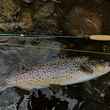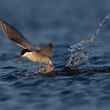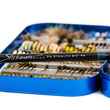What is the best fly-fishing grip? The simple answer is: the grip that feels and works best for you. Period. Though there may be no fly fishing topic that earns the ire of internet fly casting trolls, also known as the “casting police,” most of these individuals live in an echo chamber where they preach about the One Way to fly cast. What these individuals fail to understand is that no single fly casting style is best for everyone. While there are certainly tactics that work best for the masses, there’s always a minority in need of another approach.
I don’t know of anything that is more destructive to any learning environment than being taught from a dogmatic approach. Whenever I post a shot online or in a publication of someone fly casting with their finger-on-top or to the side of the grip, I get a healthy dose of messages strongly suggesting that such a grip is a terrible approach to fly casting—always without any substantive reasoning. At fly fishing shows, I hear people saying you can’t cast with your finger on the grip. I’m sure a number of these well-mannered individuals are indeed excellent casters, but they lack the openness that comes with realizing that what works for them may not work for the entire fly fishing population.
I should point out that I use a variety of grips while fly casting. My chosen grip is based on how much power is needed in the cast, the casting distance, and the type of fly rod being used. Here, I want to discuss one of my favorite grips for short range trout fishing: the finger-on-top or to the side. Note: I do use the thumb-on-top about half the time for reasons I’ll discuss below. I use each grip (thumb or finger) during the season based on the variables listed above. I do what feels comfortable for my rod hand and best suited to completing the task at hand.
Why is the grip important? A good grip is the link that transfers the energy created by the fly caster into the rod. In other words, the grip is the conduit between angler and rod. The goal of a good grip is to help the fly caster efficiently and accurately make the cast. A good connection occurs when the rod feels like mere extension of the angler’s casting hand, and it all starts with a grip that feels natural. So let’s discuss a few of your grip options.

The finger-on-top or “V Grip”
For me the most natural grip is the finger-on-top or off to the side (aka the “V grip”, a term popularized by Gary Borger). Think about your natural hand position when you shake someone’s hand and use this same hand position when holding the rod grip. Both thumb and index finger are positioned on opposite sides of the grip, forming a V shape near the bottom of the cork. Or if you want, the finger can be positioned more directly on top. What makes this grip so helpful is that your hand can travel in a smooth and straight path as it allows the hand to track straight, without wanting to curve back to its natural position. Think about how you throw darts, with the thumb and index finger off to either side of the object and you release it towards the target. The only difference is the back three fingers are holding the grip from below, allowing you to make a smooth and accurate cast. For accuracy, simply point the index finger to where you want the fly to travel to. Although many great fly casters use the thumb grip for accuracy, I feel using the index finger to point towards my intended target feels more comfortable.
Another advantage to this grip is it’s harder to break the wrist on the backcast with the finger grip. In fly casting, the goal is to usually get the rod tip to travel in a fairly straight line, which means the rod hand also needs to travel in a fairly straight path. So, if you are finding that your casting hand and rod tip are moving through too wide of a casting plane (e.g. you notice your loops are super wide), using the finger-on-top grip can immediately help tighten up your loop as this grip doesn’t allow for as much wrist rotation. Fly fishing small streams often demands tight loops, as you’re casting in tight quarters and under obstructions at close distance. Using the finger grip has helped me tighten my loops and get my fly into tight areas, while reducing the frustrations associated with such casting environments.

The thumb-on-top grip
The one disadvantage to using the finger-on-top or “V Grip” is the lack of power when compared to using the thumb-on-top. Rarely do I make casts longer than 45 feet when trout fishing, but when I do, I feel the thumb-on-top allows me to generate more power during the casting stroke. Although I know some great casters who use the finger-on-top when casting for distance, I find the thumb-on-top provides far more power during the casting stroke. Another example of a situation which will lead me to opt for the thumb-on-top approach is when I want to create a hard impact on the water when fishing beetles and grasshoppers. Think about these hard bodied insects. As they fall to the water, they create a loud “SMACK.” Often, I want to create such a disturbance to get the attention of any nearby trout and using the thumb-on-top allows me to generate more power into the cast to create such a disturbance.
It’s also worth noting that your rod action also influences the amount of power needed to make a cast. If you’re using a fast action saltwater or streamer rod, these rods can sometimes feel like broom handles with little flex. When casting such fast action/stiff rods, the thumb-on-top is often the better grip as you’ll need more force during the casting stroke to load the rod. And the opposite is true when fishing soft action, low line weight fly rods, or tenkara style rods. Today, I do most of my trout fishing (nymph, dry, and light streamer) with my 11’ 3wt Euro rod, and for this reason I use the V or finger-on-top grip most of the time with this rod. This rod is not good for distance but it is a soft tip rod that excels at short range fly fishing, requiring only the force of the finger to power the cast.
My hope is this piece will encourage you to keep experimenting with grips and find the one that works best for you. The various styles of fly casting remind me of a scene from the movie Bagger Vance. Bagger Vance (played by Will Smith) talks about how there’s “one authentic swing in each of us and is something that cannot be taught to us by others.” I think this is a beautiful way to teach all of us that while it’s helpful to learn more about any skill, it’s likely more important for us to practice and experiment with fly casting until we find our own authentic grip and fly cast. And maybe you will find that using the V grip or finger-on-top helpful with your fly-casting pursuits. And if you don’t’, that’s fine—as you at least know you’ve tried something and decided it wasn’t for you. Do what feels natural with your fly casting, avoid listening to the noise created by the “casting police”, and you’ll find your authentic cast. And sometimes that means giving them the finger.



























![Instructors John Juracek [left] and Brant Oswald [right] from The School of Trout (photo: Tim Romano). school of trout instructors john juracek brant oswald](https://www.hatchmag.com/sites/default/files/styles/gallery_thumbnail/public/field/image/romano-0024.jpg?itok=X_had7Jf)




Comments
Norman replied on Permalink
And as I get older, I most always use the finger on top and I seem to get plenty of power even in the salt. Arthritis in the thumb area will get to all of us eventually.
Owen replied on Permalink
Great article, Mr, Daniel! I agree that the finger on top grip tends to be more accurate, especially for shorter distances and when the caster also puts the casting-arm foot pointing forward to get everything in line. It's also the best and quickest way to prevent a learning from dropping the backcast in the water or practice field
John Mills replied on Permalink
This is so "spot on". As an average fly caster after 40 years of trying this is the truth. use what works! And when a guide gets on your case tell 'em--as Yosemite Sam said--"step back folks you bother me".
Pages